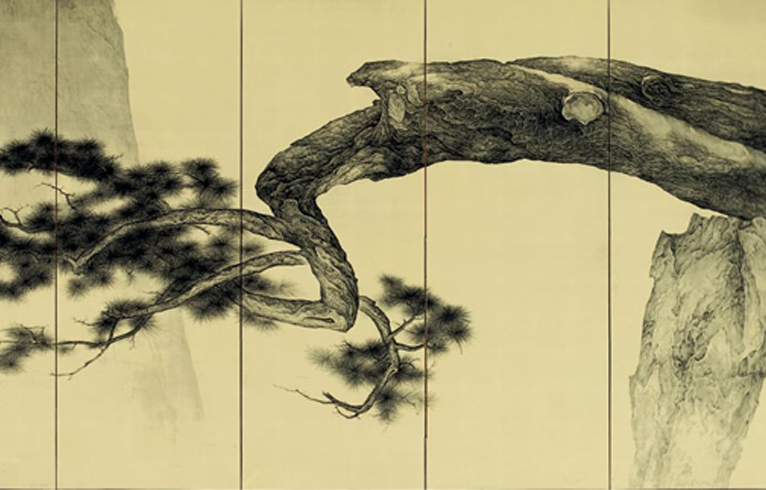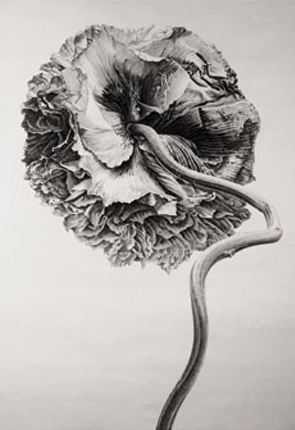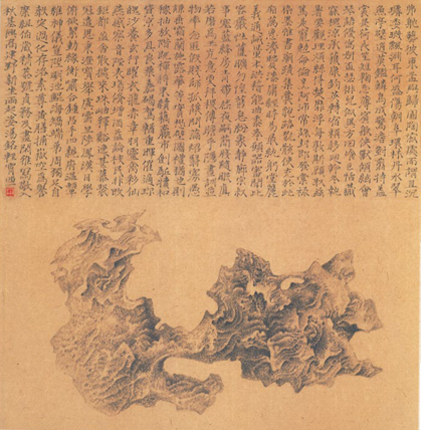RESPOND AND TRANSCEND: THE INK PAINTING OF LIU DAN AND LI HUAYI
| July 7, 2011 | Post In LEAP 9

Chinese ink and brush painting is in a strange place. On the one hand, quality works are in short supply, and a “lack of methodology” has rendered the field, as art critic Gao Minglu critiques it, “unsalvageable.” Yet on the other, strong attendance at recent exhibitions speaks to an uptick in interest in the genre, both in China and in the West.
In November of last year, the Museum of Fine Art in Boston invited ten Chinese artists to reinterpret ink and brush works from the museum’s collection. The result was the well-received exhibition “Fresh Ink: Ten Takes on Chinese Tradition.” In selecting the artists, curator Hao Sheng was upfront about his desire to avoid the “contemporary Chinese art” commonly seen on the auction circuit and in American museums. Which begs the question: what exactly is “contemporary” ink and wash painting? And what relationship does it have with tradition? In inviting Liu Dan and Li Huayi to contribute to “Fresh Ink,” Sheng said that each have “made significant breakthroughs in format. It’s like going from a flat piece of paper to three dimensions.”
Which begs the question: what exactly is “contemporary” ink and wash painting? And what relationship does it have with tradition? In inviting Liu Dan and Li Huayi to contribute to “Fresh Ink,” Sheng said that each have “made significant breakthroughs in format. It’s like going from a flat piece of paper to three dimensions.”
VISIONS
In April of this year, Li Huayi staged not one but two exhibitions. The first, “Images of the Mind,” at the National Art Museum of China, looked back at over thirty years of his work. The second, “Beyond Representation,” at the Beijing Center for the Arts, was new work. His simultaneous shows coincided with a major exhibition on traditional Chinese painting at the National Museum of China. The gaudiness of the selections served only to heighten the focus on Li.
It’s a feeling with which Kuiyi Shen, a professor of art history at the University of California San Diego, is familiar. He first saw Li Huayi’s work in 1995, at the New York gallery Kaikodo. At the time, he and his wife Julia Andrews were putting together an academic work on traditional Chinese painting. They found Li’s work a pleasant surprise. The two of them had already journeyed to Beijing, with less-than-ideal results: “I don’t even know how many paintings we looked at. They were all more or less the same, strong forms, really beautiful, but lacking that really obvious resonance with Chinese tradition.” Li’s work, on the other hand, “grabbed” them immediately. In Li’s grasp of nature, Shen saw an artist who “owed an obvious debt to tradition, but who also had obviously moved beyond that tradition.”

Around the same time, in New York’s Takashimaya Gallery, Robert Mowry, curator of Chinese art for Harvard’s art museums, was laying eyes for the first time on the work of Liu Dan. It wouldn’t be until 1997, when he finally met the artist in person, that he was able to delve into Liu’s work in greater depth. Out of his investigations came “A Tribute to Liu Dan and His Paintings,” wherein he states that, “In their quiet presentations, harmonious proportions, and balanced, self-contained compositions, Liu Dan’s paintings, like I.M Pei’s finely honed buildings, embody a classical aesthetic vision. Like classical Greek sculpture, Northern Song landscape scrolls, and Italian Renaissance paintings, Liu Dan’s works are restrained and subdued, directing the viewer’s attention to the subject portrayed rather than to the painting itself; on reflection, however, one realizes that it is the artist’s consummate mastery of style, composition, design, technique, and materials, hand-in-hand with his desire to remain in the background, that has elevated the subject to monumental status, allowing it to dominate.” It might be because of his understanding of Liu’s “classical aesthetic vision” that Mowry chose to exhibit his paintings in tandem with a selection of traditional Chinese bronze works.
LI HUAYI’S MUTED IMPACT
The details are what draw you into Li Huayi’s paintings. In their meticulousness, his paintings recall the landscape paintings of the Northern Song dynasty. But the effect is wholly modern, like a widescreen TV. For his contribution to “Fresh Ink,” Li chose to reimagine Nine Dragons, a work by the Southern Song painter Chen Rong (1210-1260), as Dragon Amidst Mountain Ridge.
The work comprises six separate screens arranged in a tight rectangle. A scroll hangs down through the middle, covering most of the third and fourth screen. Upon viewing, the eye is immediately drawn to the scroll, in its center a single, powerful rock. Mountains stretch across the screens to either side, clouds rising through the valleys between them. Li Huayi’s liberal use of light ink sets the tone, drawing the viewer into the scenery. He explains that his inspiration for the misty, clouded valleys comes from the intertwining serpentine forms of Chen’s Nine Dragons. He attempted something similar in an earlier work, Mountain Range With Receding View. But in Dragon Amidst, it’s almost as if, by running a scroll through the middle, Li has predicted the play of the viewer’s gaze. The scroll serves as a visual focus point. The considered use of modern installation techniques moves Li’s new work beyond the two flat dimensions of a more traditional work. The use of screens and scroll together slices space apart, and then rearranges it.
Li Huayi was born into a well-off Shanghainese household. In 1954, at the age of six, he began receiving instruction in Chinese painting. Before long, turned off by the tedious training, he switched instructors, beginning his study under Zhang Chongren. Zhang’s sculpting background made him a gifted sketcher, and an equally talented watercolour painter. Under Zhang’s tutelage, Li built a solid foundation in Western painting. By the time the Cultural Revolution came, Li had already graduated. He used his knack for painting to make a living, painting the propaganda posters so common at the time, and picking up a grounding in Russian realist techniques in the process. In 1982, he moved to San Francisco, entering the San Francisco Art Institute to study modern art. He spent the next ten years in an arduous search for a style of expression that would fit him. As Kuiyi Shen tells it, Li liked classic oil paintings: “His house in California was decorated like an Italian villa. There were portraits all over the walls, very realistic, very difficult to paint. But he’s got the skill to paint them.” After years of searching, one day Li found himself in front of an ink painting by Zhang Daqian. Here, he felt, was his direction: “Chinese art is a pure art. It’s completely conceptual!”

A complete, systematic education in modern and post-modern art, along with the family influences he absorbed at an early age, all led Li Huayi to the natural conclusion that the landscape paintings from the Northern Song dynasty would be the jumping-off point for his work. As Shen Kuiyi puts it, “Historically speaking, the Northern Song was a high point for Chinese painting. It was also the high water mark for the re-emergence of painting in ancient times. The style was highly realistic. After that you saw the appearance of the Southern Song painters, who completely changed things. They emphasized individual expression, individual moods. Li latched on to the points that fit him best.”
It wasn’t enough just to see the paintings, though. Li Huayi had to experience them. He became a constant presence at National Palace Museum in Taipei, and even took up mountain climbing, spending countless hours making his way up mountainsides, searching for new landscapes to see. Shen Kuiyi offers this tribute to Li’s work from the early 1990s: “It’s pure. He was just starting to develop the Chinese elements on top of his Western training. The style is moving from abstract to natural, but he’s still doing exquisite, beautiful work, with all of the lofty feel you expect from a Northern Song painting. There’s a hallucinatory aspect to his work, but it’s still easily relatable to Song paintings, especially if you’re someone with the right educational background, someone who really understands Chinese paintings. That’s why he was able to succeed so quickly in the West.”
LIU DAN’S UNIVERSE IN A LANDSCAPE
It’s easy to see the traces of “sketching” in Liu Dan’s work, to the point that people sometimes mistakenly label it as such. Liu himself affirms that before he starts an important work, he begins with a finely sketched draft. Even though he’s an accomplished sketch artist, he admits, “It’s not the easiest thing in the world to get my knowledge of sketching to harmoniously coexist with my training in traditional techniques.”
The development of Liu Dan’s technique is a case of, as the Chinese saying would have it, “knowledge proceeding from essence.” Although he has no fixed subject matter, his tendency is to work with landscapes, stones, and flowers— what he calls “uncertain” themes— because, as he puts it, “the clearer the feeling, the blurrier the image.” The “uncertainty” he’s talking about is the state of “like, but not alike” that traditional landscape painting seeks to attain, a state where stones become trees, trees melting into clouds. The subjects can interact, or they can develop on their own.
For Liu Dan, the period before the 1980s was a time of prolonged exploration of his individual style. Before the age of nineteen, the prodigiously talented Nanjing native had already taught himself to sketch Renaissance masterpieces. On the strength of a recommendation, he was admitted to the Jiangsu Chinese Painting Institute as a student of the artist Ya Ming, and turned to the study of Chinese painting. He spent the ten years of the Cultural Revolution in limbo. In 1976, after his old school reopened its doors, he regained admission; in those days, the Jiangsu Chinese Painting Institute was a graduate school, and one of the best places in the country to study. In 1979, under Ya Ming’s guidance, he spent two months studying the ancient cave paintings of Dunhuang. For Liu, if studying Renaissance art was “like love at first sight,” studying Chinese painting was “like meeting an old friend for the first time.”

In 1981, Liu Dan moved to the United States. He grew in the unfamiliar environment, spending the decade visiting every museum he could (especially those with Chinese art collections), consciously restructuring the way he looked at art. In 1986, he decided to dedicate himself to ink and brush painting. He completed his first large work a year later. Blood Field is composed of seven scrolls— six arrayed vertically, one horizontally, drawing a third dimension out of traditional two-dimensional forms. Simultaneously, he had begun what would become an extended investigation of the form and structure of so-called “odd stones” [trans. note: odd stones are an— there’s no other word for it— odd feature of traditional Chinese art, wherein stones of unusual color or banding are shaped, polished, or otherwise altered to produce the artist’s desired aesthetic result], developing a theory of landscape painting he called “micro exploration through macro understanding.” In 1993, a well-known American collector of odd stones invited Liu to view his personal collection, expressing a hope that he might commission Liu to paint one of them. Liu turned him down on the basis that “none of them were the rock I carried in my imagination.” Half a year later, the collector found the right rock. Liu would spend the next year producing his “Twelve Views of Little Openwork series”. The series catalogs the stone from twelve different angles, capturing the minutest details of its surface, to the point that the stone itself almost seems like a landscape. To Liu, the stone becomes an almost “spiritual form.” As he puts it, “when Chinese people design gardens, rockwork is the foundation. The holes and the pits in the stone create a peculiar sense of time and space.” As a result, even with its limited confines, a Chinese garden can enable a distinctive kind of spiritual travel.
Liu Dan’s achievements in stone made it practically obligatory that, for his contribution to “Fresh Ink,” he reinterpret The Honorable Old Man, a famous scholar’s rock in the MFA’s collection. In his reimagining, titled Illusions of the Old Man Rock, a stone is painted from nine different angles. The nine paintings are then fused into a full-length landscape work. At the space set aside for Liu’s work in Boston, his nine sketches surround the original work, while on the wall opposite hangs Liu’s deconstructed, re-imagined full-length landscape painting. The layout of the installation achieves the desired effect. You won’t find what you expect in Liu’s work. Nor will you find anything familiar. But, in a delightfully hallucinatory artistic sleight of hand, it may just succeed in taking you from the micro to the macro.
CAN TWO PATHS BECOME ONE?
As Robert Mowry sees it, through Li Huayi’s precise composition and choice of themes, his ability to draw inspiration from the visual language of the Northern Song, and his mastery of Western abstract expressionism, Li has managed to “reproduce the broad spirit of Northern Song landscapes. Rather than imitating, he has achieved a modern, Westernized ink painting.” Shen Kuiyi calls it “post-traditionalism,” nothing that “Here, ‘post’ means to transcend, to not fit in. His work bears a resemblance to ‘traditionalist’ works, but they come from fundamentally opposed viewpoints. He’s concerned with tradition only insofar as how he can move beyond it. But if you’re trying to get beyond something, it’s still going to leave its mark on you.”
Liu Dan’s work is difficult to sum up in a single statement. Critic Ackbar Abbas labels it “Baudelairian dandyisme.” Which might bring to mind the lifestyle of Song and Ming literati; in reality it’s nothing of the sort. Liu’s methodology instead focuses tightly on exploring the principles of creation. He says, “I never choose from among the known. I’m only interested in creating answers to the unknown.”
For example, in 1990 Liu created A Long Ink Brush Landscape, a work he painted through close observation of a candle flame. The dancing of the candle produced what he called “layers of flaked light,” layers that he used to conjure up a world in miniature. A Long Ink Brush Landscape provided the basis for an imaginative book-length investigation of the sources of Chinese landscape painting by Tsinghua Ph.D. candidate Tai Xiangzhou. Wen Fong, former chairman of the department of art and archeology at Princeton University, critiques the painting thus: “It comports entirely with the ‘Three Fars’ visual principle used to structure the interplay of the vertical with the horizontal in early Chinese landscape painting: namely, that its focal points are evenly distributed vertically [lit: high and far], horizontally [lit: flat and far], and in depth [lit: deep and far].” It’s a reminder that, while in the West, paintings are meant to be seen, in China, they were meant to be read. In “reading” Liu’s work, Fong finds that “in the cantilevered mountains, every brushstroke drips with mountain breezes. There are no flat surfaces anywhere; it’s like a sculpture.” Fong believes “in upholding orthodoxy, Liu Dan brings forth his self.”
Two artists, both born in China, both formidable practitioners of Western artistic techniques, both of whom reached intellectual maturity in the West, yet both are steadfast adherents of brush and ink painting. Each established his style in the West, in the estrangement and the perspective that comes with distance shaping the “Chinese” elements of their work into something beyond the ordinary, something imbued with the mark of the times, something “even more Chinese.” Liu Dan doesn’t even bother to conceal his resistance to the ideology behind the phrase “Chinese painting.” He prefers to call it “ink painting.” But in interviewing him, one can’t help but think back on the creative spirit of great artists from bygone eras, those who were brave enough to move beyond— and to shape— their own eras. In their form and in their technique, Liu Dan and Li Huayi have obvious differences, but nor are the similarities in their individual artistic paths difficult to spot. Whether, in the end, those two paths will converge, we can only wait and see.


